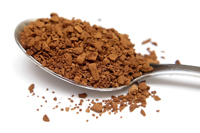Instant coffee can never be compared to real coffee made of coffee beans
U.S. public first tested the taste of instant coffee at the national fair in Buffalo in 1901. The invention gave rise to a great deal of controversy. The instant coffee still divides the world in two.

The coffee pundits still believe the energizing effects of instant coffee are a product of self-suggestion. Their reasons are well-understood. The coffee pundits are likely to die out should the coffee shops cease to exist. The Italians, the inventors of espresso, are confident that mano (hand) is a key word for the coffee-making ritual. In other words, a nice cup of coffee can only be made by a person of expertise and experience. From that point of view, the process of making a cup of instant coffee looks utterly nondescript. Anyway, sociologists maintain that the instant coffee has been one of the forerunners of the consumerist society, which all of us are part of.
It only takes half a minute for the coffee ‘powder’ to completely dissolve in hot water. The instant coffee dissolves in cold water within three minutes. The lightning speed is one of the indisputable advantages of the instant coffee. Though the price of a jar of instant coffee is more or less on a par with the price of the same amount of coffee beans, a large number of customers do appreciate the instant coffee because it is easy to use.
However, the above property of the instant coffee was a notable disadvantage in the 1950s. The majority of American housewives boycotted the fast coffee as a prefab beverage for the lazy-bones. A clever marketing campaign under the slogan: “The instant coffee will allow you to free up your time for doing more important things!” made them change their mind, eventually. According to the 1953 statistics, every American over 10 years old drank 2.57 cups of coffee a day with 2.31 cups made of coffee beans and a mere 0.26 cups of instant coffee. A fifty years on, the Americans drink 400 cups of coffee a day. The instant coffee accounts for more than a half of this number.
The consumption ratio between the coffee beans and instant coffee defines the “coffee culture.” Europeans, e.g. the Germans (not to mention the Scandinavians who are believed to be the world’s principal coffee maniacs) consume a larger quantity of ground coffee than other nations. The Russians drink more instant coffee than the Americans. The proportion between the quantities of coffee beans and instant coffee consumed by the residents of St. Petersburg alone is 1 to 7. The Brazilians turn out to be the main consumers of different brands of instant coffee.
All in all, the Brazilians could have indulged in drinking the beverage made of natural coffee beans.
Brazil was the world’s leading producer of coffee at the turn of the 20th century. More than 60% of all coffee beans were cultivated in Brazil.But gold would oftenturn to dust at a time when the coffee storage and processing technologies were yet to come. Somebody had to find a way to keep coffee from becoming a costly and barely affordable foodstuff. The Swiss chemist Max Morgentaller devised the “prototype” of the present-day instant coffee by boiling and drying ground coffee particles mixed with sugar.
The production methods have been continuously polished up. They currently include three main stages:
- The first stage involves the method of spraying and drying: the ground and toasted coffee powder is processed by hot water under pressure. The infusion is filtered and sprayed in vessels filled with hot inert gases. The droplets of the extract congeal and dry out to produce the powdered instant coffee.
- The second stage is based on granulation. The fine coffee particles get lumpy by means of hot steam. As a result, the instant coffee no longer comes in powder, it looks like a multitude of granules.
- The third stage is still considered a unique invention. The method was patented in 1965. It involves the freeze-dry process. The coffee extract is preserved by freezing and then drying in a vacuum. The method does not involve any heat treatment, and therefore the product has a greater content of natural ingredients. In terms of aroma, a cup of the freeze-dried instant coffee can compete with a cup of coffee made from the freshly toasted coffee beans. In comparison with other varieties of instant coffee, the freeze-dried instant coffee is on top of the list when it comes to palatability.
Arabica coffee is the principal species of coffee cultivated in Latin America, and the chief coffee tree of commerce. It is rarely used for producing instant coffee. The beverage made from Arabica coffee seeds is aromatic yet fairly mild. The grade’s characteristic flavor is virtually lost in powdered instant coffee. The beverage made from Robusta coffee, the stronger species native to Africa, and cultivated in warm regions of the Old World, is more saturated. Robust coffee seeds contain twice as much caffeine and extractives than the Arabica coffee.
It is the caffeine that cheers us up as we drink a cup of coffee. The caffeine content in a coffee seed equals 2-3% of its total weight. However, the above content of caffeine is believed to be exceedingly high for the modern humans who live in a stressful world. Therefore, instant coffee’s caffeine content is decreased during manufacture to 2.3% in order to meet the international standards. In theory, the caffeine content in instant coffee must not go below the above level. On the other hand, some instant coffee brands contain as little as 0.1% of caffeine.
Gastromag.ru
Translated by Guerman Grachev
Pravda.Ru
Subscribe to Pravda.Ru Telegram channel, Facebook, RSS!

